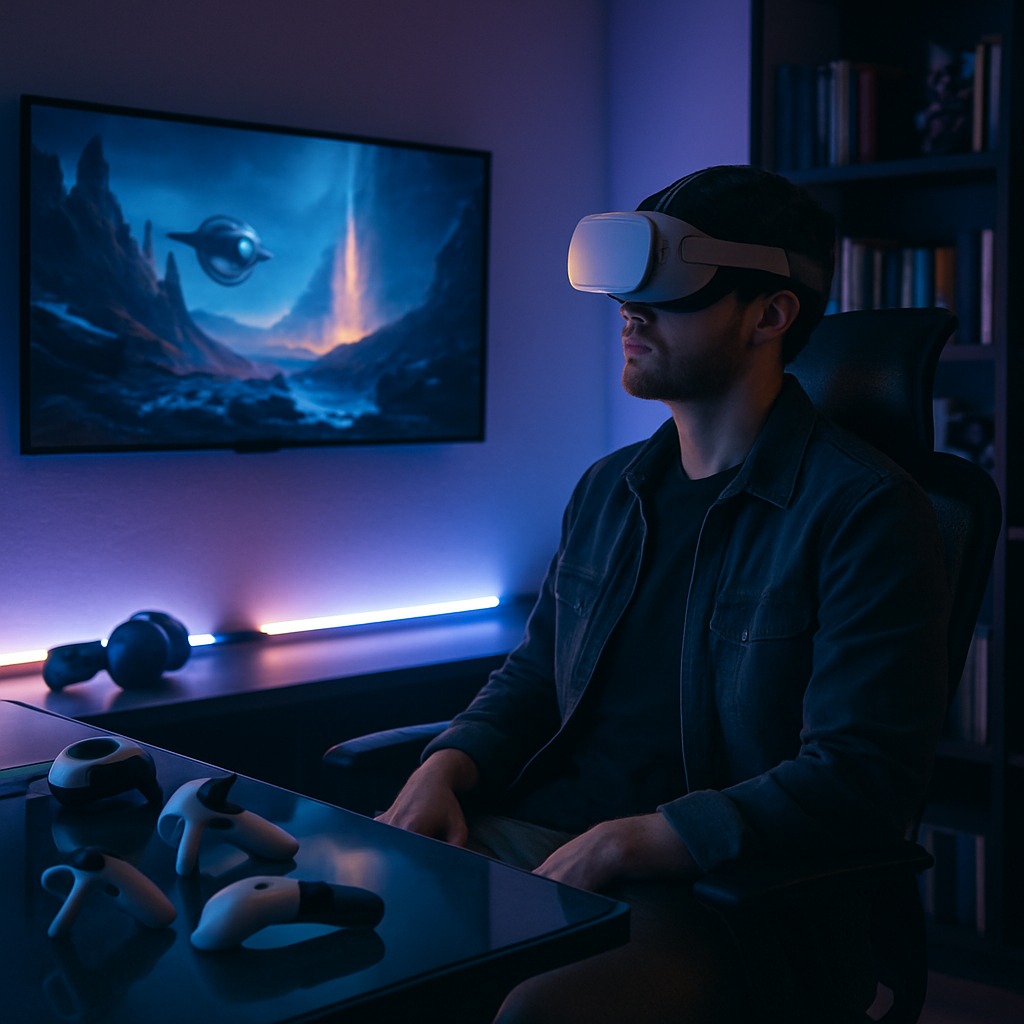
Virtual reality has transformed from science fiction fantasy to a revolutionary tool in modern filmmaking. Though filmmakers have dreamed about immersive experiences since cinema’s earliest days, only recent technological advances have made VR a practical reality in movie production and viewing. This shift represents one of the most significant evolutions in how we create and consume film.
The relationship between cinema and virtual reality has grown increasingly symbiotic. Filmmakers use VR tools to visualize complex scenes before shooting, while VR developers draw inspiration from cinematic techniques to create more engaging virtual experiences. This cross-pollination has accelerated innovation in both fields, pushing the boundaries of what’s possible in visual storytelling.
From Fantasy to Filmmaking Tool
Virtual reality’s journey into cinema began long before the technology existed. Directors like Stanley Kubrick with “2001: A Space Odyssey” (1968) and Steven Lisberger with “Tron” (1982) imagined digital worlds that foreshadowed VR’s potential. These early conceptual explorations planted seeds in the minds of both filmmakers and technologists.
The 1990s brought the first serious attempts at VR in entertainment, though primitive by today’s standards. Films like “The Lawnmower Man” (1992) introduced mainstream audiences to virtual reality concepts, even as the actual technology remained clunky and prohibitively expensive. Brett Leonard, who directed that film, later reflected, “We were trying to visualize something that the technology couldn’t actually deliver yet.”
Fast forward to the 2010s, when affordable VR headsets finally emerged. Oculus Rift’s 2012 Kickstarter campaign marked a turning point, raising nearly $2.5 million and signaling massive public interest. Facebook’s $2 billion acquisition of Oculus in 2014 further legitimized VR as a mainstream medium.
Filmmakers quickly recognized VR’s potential beyond consumer entertainment. Directors began using virtual reality as a pre-visualization tool, allowing them to explore virtual sets and plan complex shots before expensive physical production began. Alfonso Cuarón employed VR techniques while planning the intricate long takes in “Gravity” (2013), enabling him to choreograph camera movements through a virtual space station.
“It completely changed how I approached the blocking,” Cuarón said in a 2013 interview. “I could actually walk through the space and see exactly what the camera would capture from different angles.”
This pre-visualization capability has proven particularly valuable for films with elaborate special effects. For “The Jungle Book” (2016), director Jon Favreau used VR to walk through his virtual jungle before a single frame was rendered at final quality. This approach has since become standard practice for effects-heavy productions.
The pandemic accelerated this trend dramatically. When physical production became challenging during lockdowns, filmmakers turned to virtual production techniques that combined VR tools with real-time game engines. Shows like “The Mandalorian” pioneered the use of massive LED walls displaying virtual environments created in Unreal Engine, with directors using VR headsets to scout and design these digital locations.
New Narrative Frontiers
Beyond production tools, VR has opened entirely new storytelling possibilities. Traditional cinema operates within a fixed frame, with the director controlling exactly what the audience sees. VR narratives, by contrast, allow viewers to look anywhere within a 360-degree environment, creating unique challenges for storytellers.
Alejandro G. Iñárritu’s “Carne y Arena” (2017) demonstrated VR’s potential for creating empathy. This installation placed viewers in the shoes of migrants crossing the U.S.-Mexico border, using the medium’s immersive qualities to create a powerful emotional experience. The project received a special Oscar, recognizing it as a new form of cinematic expression.
“I wanted people to go through a direct experience far beyond the normal limitations of cinema,” Iñárritu explained at Cannes. “VR allowed me to erase the border between subject and audience.”
Major studios have experimented with VR tie-ins for blockbuster releases. Disney created “Coco VR” to accompany Pixar’s “Coco” (2017), allowing users to explore the film’s colorful Land of the Dead. Warner Bros. developed “Blade Runner 2049: Memory Lab” as a companion piece to the film sequel, extending the story world beyond the theatrical experience.
These experiments highlight both the potential and limitations of VR storytelling. While immersive experiences can create powerful emotions, they often sacrifice the precise control that makes traditional cinema so effective. A director can’t guarantee where a VR viewer will look during crucial moments, complicating traditional narrative techniques.
Some filmmakers have embraced this challenge by developing new grammar for VR storytelling. Techniques like spatial audio cues, lighting design, and character movement help guide viewer attention without forcing it. Projects like Baobab Studios’ “Invasion!” (2016) successfully adapted animation techniques to the VR medium, showing how storytelling can evolve to fit new technological constraints.
The line between film and video game has blurred further with interactive VR narratives. Netflix’s “Bandersnatch” (2018), while not VR-based, demonstrated audience appetite for interactive storytelling. VR projects have taken this further, with experiences like “The Under Presents” combining live actors with virtual environments to create something between cinema, gaming, and immersive theater.
During a 2019 virtual production workshop I attended, veteran cinematographer Bradford Young expressed both excitement and caution about these developments. “These tools give us incredible freedom,” he noted, “but we shouldn’t get so caught up in the technology that we forget what makes stories connect with people in the first place.”
Accessibility and Future Directions
Despite technological advances, VR cinema faces significant adoption challenges. Headsets have improved dramatically but remain relatively expensive and cumbersome compared to traditional screens. The isolation of current VR experiences also contradicts cinema’s social nature – watching a movie in VR typically means cutting yourself off from others physically present.
Some companies are working to address these limitations. Venues like THE VOID created location-based VR experiences tied to film franchises like “Star Wars” and “Ghostbusters,” allowing groups to share virtual adventures together. Though many such venues struggled during the pandemic, the concept demonstrated how VR could maintain cinema’s social dimension.
Distribution platforms for VR content have also evolved. YouTube supports 360-degree videos viewable on phones, computers, or headsets, while specialized platforms like Oculus TV curate VR experiences. Traditional studios have approached this new medium cautiously, uncertain about revenue models for content that reaches a relatively small audience.
The technology continues advancing rapidly. Mixed reality systems like Microsoft’s HoloLens blend virtual elements with the physical world, potentially addressing VR’s isolation problem. Companies like Varjo are developing headsets with human-eye resolution, eliminating the visual compromises of current systems. These improvements could eventually make virtual cinema experiences indistinguishable from reality.
Looking forward, we might see a convergence of cinema and gaming technologies. Unreal Engine 5, released in 2021, can render photorealistic environments in real-time, enabling directors to capture final-quality footage directly from virtual productions. As these tools become more accessible, the distinction between traditional filmmaking and virtual production will likely continue to blur.
Steven Spielberg’s “Ready Player One” (2018) offered a vision of VR’s future that was simultaneously exciting and cautionary – a world where virtual experiences become more appealing than reality itself. While we’re far from that scenario, the film highlighted both the potential and risks of increasingly immersive media.
The evolution of virtual reality in cinema represents more than just technological progress – it reflects changing relationships between creators, audiences, and stories themselves. As traditional boundaries dissolve between different media forms, we’re witnessing the birth of new artistic possibilities that combine the emotional power of film with the agency and immersion of interactive experiences.
Whether VR eventually replaces traditional cinema or simply complements it remains an open question. What’s clear is that these technologies have permanently altered how movies are made and experienced, opening doors to forms of storytelling previous generations could only dream about. Like the transition from silent films to talkies or black-and-white to color, VR represents not just a new tool, but a fundamental expansion of cinema’s expressive potential.

